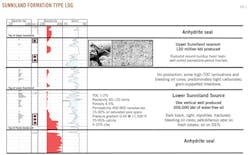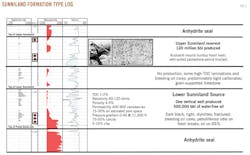Sunniland shale—an emerging South Florida basin liquids play
Brandt Temple
Sunrise Exploration & Production
New Orleans
Oil and gas producers are in the infant stages of a new liquids-rich play in the South Florida basin that could revive the oil industry in rural-agricultural parts of South Florida.
This part of Florida commenced conventional oil production in the early 1940s from the upper part of the self-sourced Sunniland formation, a porous, early Cretaceous limey marlstone. Peak production from this upper porous section (and for the basin) was reached in the mid 1970s at 17,000 b/d of oil, and since inception 120 million bbl have been produced from 14 fields that were full to spill point.
The best vertical wells made 4 million bbl each, and 40 of the vertical wells have produced at least 1 million bbl each.
Current production in the basin has declined to a few thousand barrels per day, but recent horizontal wells drilled into the Upper Sunniland are starting to turn production around. One of the more encouraging horizontal wells had a 30-day average initial potential of 1,200 b/d and has produced 200,000 bbl in its first 10 months.
Geological overview
The Cretaceous Sunniland limestone is a self-contained source and reservoir system that is sandwiched between two salt layers.
The Sunniland is divided into two zones, an Upper (reservoir) and Lower (source). Fourteen structural closures within the Upper Sunniland produced 120 million bbl of oil from subaerially induced porosity zones that are all full to spill point. The organic-rich "Lower Sunniland shale" is the geochemically fingerprinted source rock of the entire 120 million bbl of Upper Sunniland production.
Lower Sunniland shale
Although hundreds of successful completions have been made in the Upper Sunniland limestone, only one completion attempt in the Lower Sunniland shale has ever been made.
Humble Oil & Refining Co. (Exxon) perforated 20 ft of the Lower Sunniland shale in the late 1960s and established conventional production in a vertical well with no fracture stimulation. That slightly overpressured well had an initial potential of 118 b/d and has produced about 300,000 bbl of oil during the past 40 years with no water.
Smackover, Tuscaloosa comparisons
The Sunniland (110 million years old) limestone is geologically reminiscent of its older cousin, the Jurassic Smackover (155 million years old) limestone of the US Gulf Coast.
Land in the Smackover Brown Dense play in North Louisiana and South Arkansas in late 2011 has been going for $700/acre for an 8-year lease at 22% royalty.
The Smackover, like the Sunniland, exhibits subaerially induced porosity zones in its upper portion, whereas its lower portion contains a highly organic limey-marl source zone that is referred to as the "Brown Dense."
This prolific Brown Dense carbonate has sourced billions of barrels of oil in the Gulf Coast, and it is being heavily targeted at present for horizontal drilling, most notably by Southwestern Energy Co. and Devon Energy Corp. The companies have spent $160 million ($325/acre) acquiring 4-year paid-up leases with 4 year extensions at $325/acre on 500,000 acres.
Both companies are completing their first test wells. In contrast to the Brown Dense, the Lower Sunniland has not been drilled horizontally.
Another liquids play that the Sunniland matches up with is the Tuscaloosa Marine shale, which is garnering recent industry attention.
Tuscaloosa marine shale land has been going for $600/acre for 5-year leases at 25% royalty.
Devon Energy and Encana Corp. have spent $120 million acquiring 400,000 acres of 3-year paid-up leases at $300/acre with 2 year extensions at $300/acre and 78% net revenue interest.
The primary zone of interest, a high log resistivity (5+ ohms) zone, is located at the base of the Tuscaloosa Marine shale section and is found at about 12,500 ft.
Conventional production from this section was established in 1992 by a vertical well in Tangipahoa Parish of southeastern Louisiana. This well has produced more than 20,000 bbl of oil with no water at a rate of 1-2 b/d for the last 19 years.
There are a number of reports of oil shows on mud logs from wells penetrating the section throughout the study area. In comparison, Lower Sunniland has resistivities ranging from 7 to 200 ohms, is found at 11,500 ft, and has produced around 300,000 bbl of oil with no water over 40 years at rates of 30-120 b/d, and has not been drilled horizontally or fracture-stimulated with modern techniques.
Sunniland proprietary work
The technical team at privately held Sunrise Exploration has extensively evaluated both the Upper and Lower Sunniland intervals.
Results of these studies indicate that the basal source rock within the Sunniland has the right mix of rock properties to be the next repeatable liquids-rich play. Over the past 2 years we have conducted more petrophysical tests and accumulated more shale data on Sunniland than the rest of industry combined. Our tests indicate an impressive mix of reservoir and source rock properties that point to an overlooked oil resource play.
We have gathered and analyzed rock data from old cuttings from 35 wells that fully penetrated the entire Sunniland. Given the vintage of the cuttings (much of it 1950s) and given that cuttings inherently dilute readings from organic-rich laminations, we were encouraged by results that surpassed our expectations not just in the Lower Sunniland shale but also in two other prospective liquids-rich zones, the Dollar Bay and Pumpkin Bay.
Our petrophysical results and geology indicate that the Lower Sunniland possesses the critical properties necessary to be a successful play and compares favorably to other productive oil plays in the US.
The Lower Sunniland shale is a thick, mappable, porous, carbonate section that is laminated, highly organic, very brittle, slightly overpressured, and commonly oil-saturated.
Old wells throughout our acreage position demonstrate hundreds of live oil shows in the Lower Sunniland in the form of bleeding live-oil cores and DSTs with oil to the surface. Furthermore, the Lower Sunniland has been perforated only once in the basin, and that slightly overpressured vertical well produced 300,000 bbl of water-free oil.
Other South Florida targets
In addition to the Lower Sunniland target, there is another Cretaceous source rock 1,500-3,000 ft below the Sunniland called the Pumpkin Bay.
The Pumpkin Bay is another highly organic carbonate, and Sunrise E&P proprietary results exhibit even stronger petrophysical source characteristics for it than for the Lower Sunniland.
Few wells have penetrated the Pumpkin Bay, but early indications are that it's thicker and potentially more organic than Sunniland, which makes it more thermally mature and helps explain a number of gassy condensate shows.
Acreage considerations
Sunrise has leased and recorded 8-year leases on 135,000 acres in a core area where we stacked our best sample results with where the best horizontal wells in the Upper Sunniland have averaged 1.2 million bbl/well, and where individual conventional vertical wells have produced more than 4 million bbl/well.
This area is clearly more productive with respect to the average Upper Sunniland producers (700,000 bbl/well), and we believe the reason is better source characteristics in the Lower Sunniland. Although we aren't including it in our economics, we also believe that there are missed pockets of Upper Sunniland conventional potential that will be revealed with new seismic programs.
Bibliography
Acquaviva, Daniel, "Lehigh Park field seen as indicator of South Florida offshore potential," OGJ, Mar. 8, 2010, p. 32.
Gohrbandt, Klaus, "Eastern Gulf of Mexico—2: Here is habitat of oil and gas under W. Florida shelf, slope," OGJ, Jan. 28, 2002, p. 48.
Gohrbandt, Klaus, "Eastern Gulf of Mexico—1: A look at regional deposition under W. Florida shelf, slope," OGJ, Jan. 21, 2002, p. 26.
Tootle, Charles, "Reserves estimated, production listed for Florida's 22 oil fields," OGJ, Oct. 21, 1991, p. 84.
The author
More Oil & Gas Journal Current Issue Articles
More Oil & Gas Journal Archives Issue Articles
View Oil and Gas Articles on PennEnergy.com



